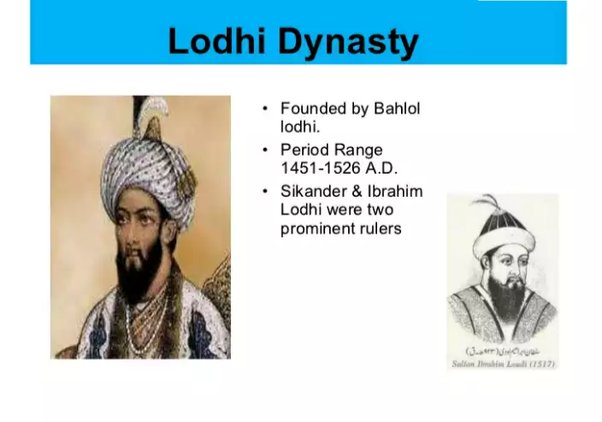
5.THE LODHI DYNASTY
(AD 1451-1526)
Considered as the first Afghan dynasty of India.
They were ruling over Sirhind, while Sayyids ruled over India.
1.Bahlol Lodhi (ad 1451-1489)
Founder of Lodhi dynasty in India.
Revived Sultanate to quite an extent.
Annexed the entire Sharqi kingdom and issued Bahlol coins.
Never sat on the throne, used to sit on carpets along with Amins.
2.Sikandar Lodhi (AD 1489-1517)
Noblest of the three Lodhi rulers, real name was Nizam Khan (Son of Bahlol Lodhi). Conquered Bihar and Bengal in AD 1504, he built a new city Agra and made it his capital. He was the son of Bahlol Lodhi.
He was a Muslim fanatic and broke the sacred images of Jwalamukhi temple at Nagarkot and ordered the temple of Mathura to be destroyed.
He set-up an efficient espionage and judiciary system and introduced the system of auditing of accounts.
He encouraged agriculture, For measurement of land, he introduced Gaj-i-Sikandari
He was a poet and wrote verse in Persian under the pen-name of Galrukhi.
He repaired the Qutub Minar.
3.Ibrahim Lodhi (1517-1526)
Ibrahim Lodhi arrested the absolute power of the Sultan. As a result, some of the nobles turned against him. At last, Daulat Khan Lodhi, the Governor of Punjab, invited Baur to overthrow Ibrahim.
He captured Gwalior and was defeated by Rana Sanga of Mewar.
He was defeated and killed at the hands of Babur in the First Battle of Panipat in AD1526. This marked the end of the Delhi Sultanate.
Causes of the Decline of the Delhi Sultanate
Despotic, autocratic and military forms of government.
Wars of succession.
Financial instability
Vastness of the empire and improper administrative control.
Unsuccessful experiments of Muhammad-bin-Tuglaq. Timur’s invasion
Incompetent nobility and increase in number of slaves during Firoz Tughlaq.
THE SULTANATE ADMINISTRATION
The Turkish Sultans in India declared themselves Lieutenants of Caliphate of Baghdad in Khutba, but he had only a moral position.
Political, legal and military authority was vested in the Sultan. He was responsible for administration.
He was the Commander-in-Chief of the military forces.
The country was divided into Iqtadars and could be transferred.
The key figure in the administration was Wazir. In the earlier period, the Wazir was primarily a military leader, but now he began to be considered more as an expert in the revenue affairs and supervised the collection of income and expenditure.
The head of the military department was called Ariz-i-Mamalik. The responsibility of Ariz was recruitment, payment and inspection of the army.
Diwan-i-Rislat dealt with religious matters. It was presided over by a Chief Sadr or Chief Qazi. The Qazi dispensed civil law based on Muslim law (Sharia)
Diwan-i-Insha, headed by Dahir-i-Mumalik, managed the royal correspondence.
The rulers posted intelligence agents called Braids in different parts of the empire to keep themselves informed.
Wakil-i-Dar was responsible for the maintenance of proper decorum at the court. The province was divided into Shiqs and headed by Shiqdras. The next unit was Pargans, a group of hundred villages, healed by the Chaudhary. Pargana was also headed by Amil. Khuts were the landowners.
Other Developments
Quwwat-ul-Islam mosque, Delhi Built by Qutubuddin Aibak.
Adhai din ka Jhonpra Ajmer: Qutubuddin Aibak.
Alai Darwaja, Qutub Minar: Alauddin Khalji
Jamat Khan Masjid at dargah of Nizamuddin Auliya: Alauddin Khalji
Siri (city), Hauzkhas tank, Hazar Situn: Alauddin Khalji
City of Tughlaqabad founded by Ghiyasuddin Tughlaq. City of Jahanpanah and Adilabad fort: Muhammad-bin-Tughlaq.
City of Jaunpur Hissar Firozabad: Firoz-shah Tughlaq.
Amir Khusro
He was a Persian poet (AD 1253-1325) associated with royal courts of more than seven rulers of the Delhi Sultanate.
He was also a musician and invented the Sitar. He innovated Khayal (a style of singing)
In his book Tarikh-i-Alai, he gave an account of the conquests of Alauddin Khalji.
His book Ashiqa, contains the love story of Deval Rani and Khizr Khan.
In his book Nuh-Sipihr or Nine Skies, he gave the story of Sultan Mubarak Shah. He also lived in the court of Ghiyasuddin Tughlaq and wrote Tughlaqnamah.
Khusro is also known as Tuti-i-hind or ‘Parrot of India’.
Kashmir
Shamsuddin Shah became the first Muslim ruler of Kashmir in AD 1339.
Zainulabdin (AD 1420-70) was the greatest ruler of Kashmir, also known as ‘Badshah’ and the Akbar of Kashmir
He accepted the policy of tolerance, introduced the art of shawl making in Kashmir, built Zaina Lanka and an artificial island in the Wular Lake.
Later ruled by Chak Dynasty, whose ruler submitted to Akbar in AD 1586
It is believed that women played an important role in the history of Kashmir.
